Common name: leek Botanical name: Allium porrum Origin: Mediterranean, Egypt
Varieties
Titan (120 days); American Flag (120 days); Broad London (130 days); Tivi
(115 days).
Description
The leek is a hardy biennial grown as an annual. It’s a member of the onion family, but has a stalk rather than a bulb and leaves that are flat and straplike instead of hollow. The Welsh traditionally wear a leek on St.
David’s day (March 1) to commemorate King Cadwallader’s victory over the Saxons in A.D. 640, when the Welsh pulled up leeks and wore them as ID’s. The more decorous now wear a daffodil instead.
Where and when to grow
Leeks are a cool-weather crop. They’ll tolerate warm temperatures, but you’ll get better results if the days are cool; temperatures under 75°F produce the best yields. Plant leeks from seed in the spring four to six weeks before the average date of last frost and from transplants in fall for a late harvest. Plant transplants in spring if you want to speed up the crop to avoid a hot summer.
How to plant
Leeks like a place in full sun and thrive in rich, well-worked soil with good drainage. When you’re preparing the soil, dig in a complete, well-balanced fertilizer at the rate of one pound per 100 square feet or 10 pounds per 1,000 square feet. Plant the seeds an eighth inch deep in rows 12 to 18 inches apart, and thin them six to nine inches apart. To plant transplants, make holes six inches deep, about six to nine inches apart, in well-worked soil. Double rows save space; to makethem, stagger the plants with their leaves growing parallel to the rows so they will not grow into the pathway. Drop the leeks in the holes, but do not fill in with soil. Over a period of time, watering will slowly collapse the soil around the leeks and settle them in.
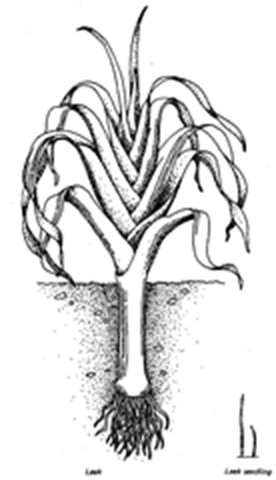
Special handling
In order to grow a large, white, succulent leek, blanch the lower part of the stem by hilling the soil up around the stalk as It develops.
Fertilizing and watering
Fertilize before planting and again at midseason, at the same rate as the rest of the garden. Detailed information on fertilizing is given in “Spadework: The Essential Soil” in Parti.
Give leeks plenty of water to keep them growing strongly.
Pests
Onion thrips may show up on leeks in dry weather. Discourage them by hosing them off the plants, or spray them with Malathion or Diazinon, Leeks will do well in the organic garden despite the thrips. More detailed information on pest control is given in “Keeping Your Garden Healthy” in Part 1.
Diseases
Leeks have no serious disease problems.
When and how to harvest
Time from planting to harvest is about 80 days from transplants and 120 days or more from seed. A 10-foot double row should give you about 20 leeks. Around midsummer, start removing the top half of the leaves. This will encourage greater growth of the leek stalk. Pull the leeks as you need them, but harvest them all before frost.
with small, yellowish flowers on the stalk. The lettuce most commonly found in supermarkets (iceberg or head lettuce) is the most difficult to grow in the home vegetable garden. Butterhead and bibb lettuces, which are often so extravagantly expensive in the store, are easier to grow. Butterhead lettuces have loose heads and delicate crunchy leaves. Stem lettuce (celtuce) might fool you into thinking you’re eating hearts of palm and makes a crunchy addition to a salad. Celtuce is grown in the same way as lettuce, except that you want celtuce to bolt or go to seed, because you’re going to harvest the thickened stem. You use the leaves of celtuce as you would regular lettuce; the heart of the stem is used like celery. Cos or romaine lettuce forms a loose, long head and is part way between a butterhead and leaf lettuce in flavor. Leaf lettuce is delightfully easy to grow, grows fast, and provides bulk and color to salads.
Leaf lettuce and butterhead lettuce make attractive borders or accents in a flower garden, and either kind can be grown singly in a four-inch pot or in a window box. With a little planning you can grow an entire salad garden in containers on a balcony or terrace. Historically, King Nebuchadnezzar grew lettuce in his gardens in ancient Babylon. The Romans used lettuce as a sedative.
Where and when to grow
Lettuce is a cool-season crop, usually grown from seed planted in the garden four to six weeks before your average date of last frost. Long, hot summer days will make the plants bolt, or go to seed; when this happens the plant sends up a flower stalk and
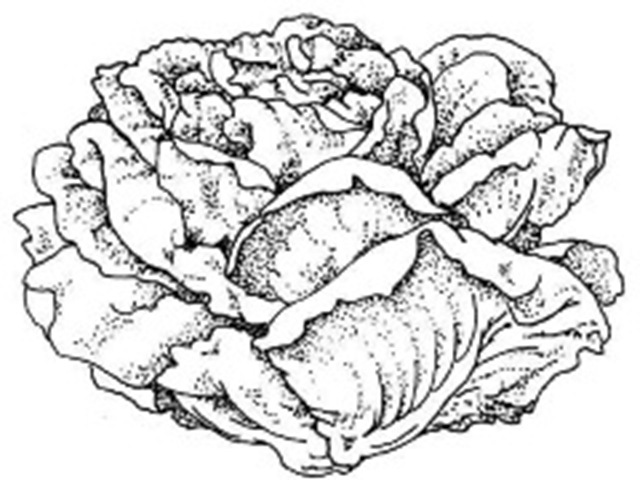
Bibb lettuce
becomes useless as a vegetable. If your area has a short, hot growing season, start head lettuce from seed indoors eight to 10 weeks before your average date of last frost and transplant it as soon as possible so that the plants will mature before the weather gets really hot. Sow succession crops, beginning in midsummer. In a mild-winter climate, grow spring, fall, and winter crops.
How to plant
Lettuce needs well-worked soil with good drainage and moisture retention. When you’re preparing the soil, dig in a complete, well-balanced fertilizer at the rate of one pound per 100 square feet or 10 pounds per 1,000 square feet. Start transplants from seed eight to 10 weeks before your average date of last frost. If you are direct-
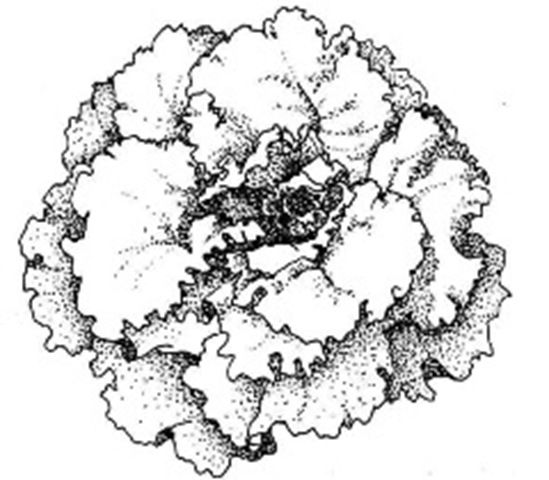
Leaf lettuce
seeding lettuce in the garden, sow seeds a quarter inch deep in wide rows, and when the seedlings are large enough to handle, thin leaf lettuce to stand six to eight inches apart and head lettuce 12 inches apart. Thinning is important; heading lettuce won’t head, and all lettuce may bolt if the plants are crowded. Transplant the thinnings.
Fertilizing and watering
Give the entire garden a midseason application of fertilizer. Your successive crops of lettuce will benefit from it, even though you will already have harvested an early crop. Detailed information on fertilizing is given in “Spadework: The Essential Soil” in Parti.Always keep the soil evenly moist but not soggy, and don’t let the shallow-rooted lettuce plants dry out. Heading lettuce

Head lettuce
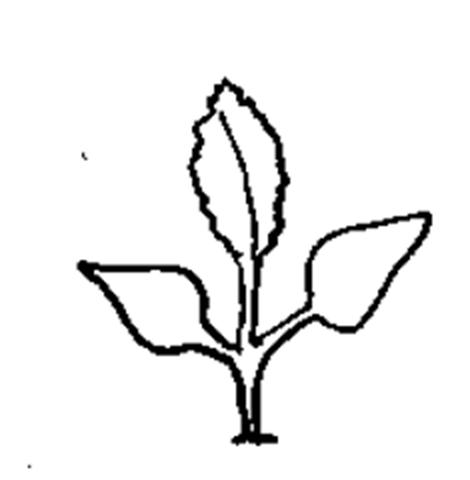
Lettuce seedling
needs careful watering when the head is forming. Try not to splash muddy water on the lettuce plants — the cleaner they are, the easier they are to prepare for eating. Use a light mulch of straw or hay to keep soil off the leaves.
Pests
Cutworms, slugs, and snails can be troublesome. You may also have to deal with aphids. Put a collar around each plant to discourage cutworms, and trap slugs and snails with a saucer of
stale beer set flush to the soil. To control aphids, pinch out infested foliage, or hose the aphids off the plants. Control aphids chemically with Malathion or Diazinon, taking care to spray the undersides of the leaves. Detailed information on pest control is given in “Keeping Your Garden Healthy” in Part 1.
Diseases
Lettuce has no serious disease problems.
When and how to harvest
As the lettuce grows, either pick the outer leaves and let the inner leaves develop, or harvest the whole plant at once by cutting it off at ground level. Try to harvest when the weather is cool; in the heat of the day the leaves may be limp. Chilling will crisp up the leaves again.
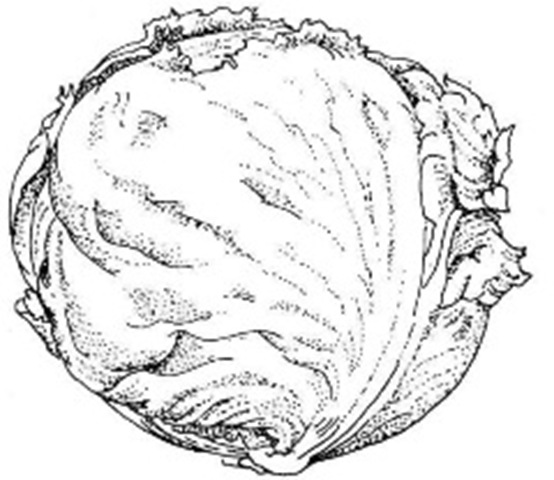
Head lettuce
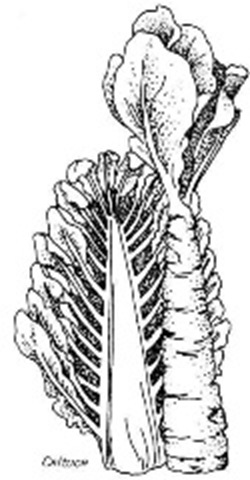
storing and preserving
Don’t harvest lettuce until you’re ready to use it. It can be stored for up to two weeks in the refrigerator, and everyone has a favorite way of keeping it crisp. Some suggest washing the lettuce first, then wrapping it in a cotton or linen towel and keeping it in the refrigerator. Others suggest storing the whole lettuce in a plastic bag. You can’t freeze, dry, or can lettuce, but you can sprout lettuce seeds. If you’ve got lots, share your bounty with friends. Detailed information on short-term storage is given in
Part 3.
Serving suggestions
Yes, salads, of course — but there are other ways to serve lettuce. Braise it in butter with seasoning to taste — the French use nutmeg. Make a wilted salad or cream of lettuce soup, or stir-fry it with mushrooms and onions. Cook peas and shredded lettuce together in a little butter — throw in the lettuce just before you take the peas off the heat. Use several varieties of lettuce together for an interesting combination of shades and textures. Serve a very plain salad — a few leaves of lettuce dressed with oil and a good wine vinegar — to cleanse the palate between courses of a fancy dinner.
